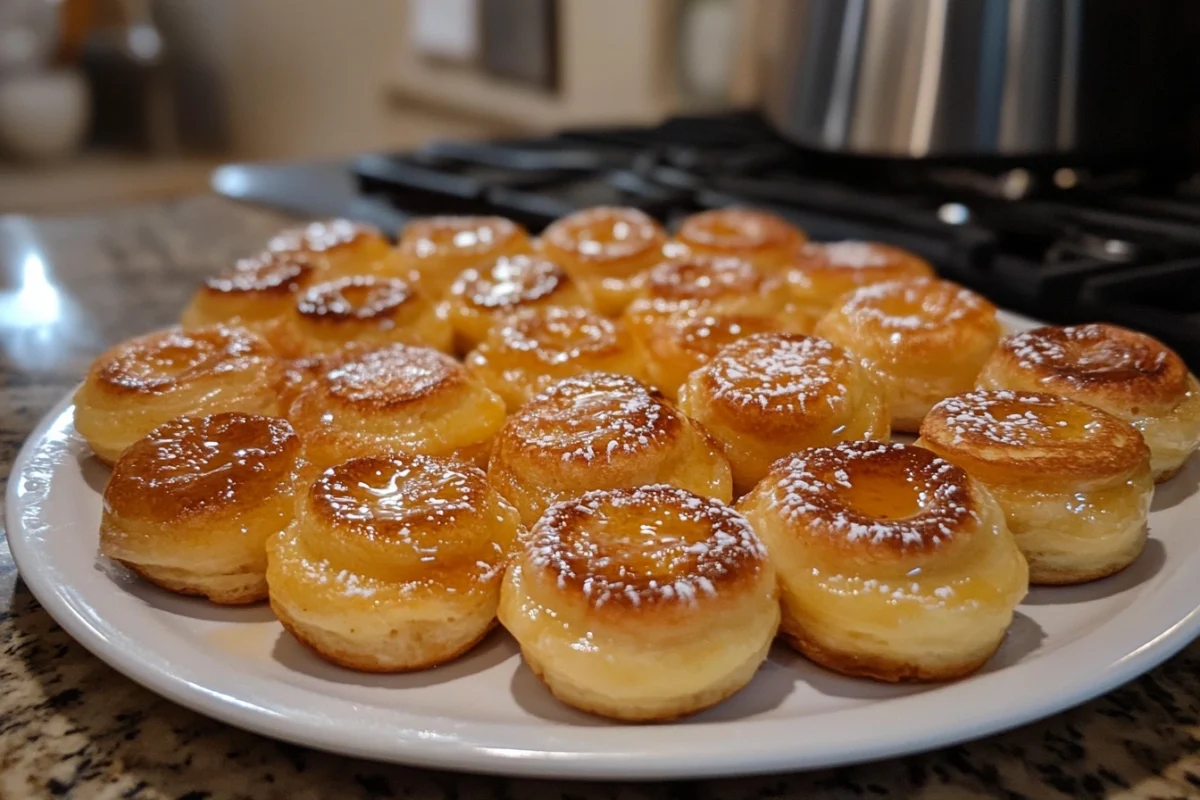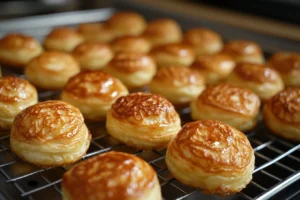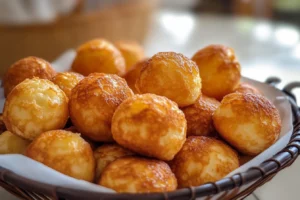Introduction and Historical Background
Introduction
Small pancakes are a favorite treat enjoyed around the world, offering a fluffy, bite-sized delight that can be sweet or savory. From street food in Europe to elegant dishes in fine restaurants, mini pancakes hold cultural importance across many regions. These tasty treats are not only versatile but also simple and quick to make, making them ideal for any occasion.
If you’re curious about tips for keeping ingredients balanced in your baking, explore techniques similar to Why Add Sprite to Cake Mix?.
- Whether you’re enjoying Dutch poffertjes, Danish aebleskiver, or Russian blinis, each culture puts its own unique spin on these small pancakes. They are often paired with toppings like butter, icing sugar, or savory options such as cheese and smoked salmon.
What makes them so universally loved? Their simplicity, versatility, and the ability to combine flavors make them a crowd favorite. Therefore, understanding the origins and cultural significance of small pancakes helps us appreciate their diversity even more.
The Historical Origin of Small Pancakes
The history of pancakes dates back thousands of years, making them one of the oldest prepared foods in human history. However, the concept of small pancakes began to gain popularity much later. Cultures across the globe adopted these miniature versions for both practical and culinary purposes.
- Early Beginnings:
Archeological evidence suggests that pancakes have been consumed since the Stone Age. Ancient Greeks and Romans prepared early versions of pancakes using wheat flour, olive oil, and honey. - Medieval Europe:
In Europe, pancakes became a staple food due to their simplicity and affordability. During this period, mini pancakes started to emerge in various regions, particularly for festive and market occasions. - Cultural Variations:
Different countries soon developed their versions of small pancakes:- The Netherlands introduced poffertjes, fluffy mini pancakes often served at fairs and festivals.
- Denmark created aebleskiver, spherical pancakes enjoyed during holidays.
- Russia brought forth blinis, which are delicate pancakes often paired with toppings like caviar.
As these cultures embraced mini pancakes, they adapted them to suit their local ingredients and traditions. For example:
- The Dutch used yeasted batter and special pans to create their signature poffertjes.
- In Japan, the creation of takoyaki, octopus-filled pancake balls, brought a savory twist to the concept.
Why Small Pancakes Are Popular Worldwide
Small pancakes gained widespread appeal for several key reasons:
- Convenience:
- These mini delights are quick to make and easy to serve, making them perfect for both everyday meals and special occasions.
- Versatility:
- From sweet toppings like syrup and sugar to savory fillings such as cheese or seafood, small pancakes offer endless possibilities.
- Cultural Significance:
- In many countries, small pancakes are tied to local traditions and festivals. For example, poffertjes are commonly enjoyed during Dutch fairs.
- Universal Appeal:
- Whether served as street food or elegant appetizers, their compact size and light texture make them a favorite among people of all ages.
Therefore, small pancakes have not only stood the test of time but also evolved into culinary symbols of joy and celebration across continents.
Conclusion
The journey of small pancakes from ancient kitchens to modern-day menus clearly highlights their timeless appeal and deep cultural significance. Over time, these miniature delights have evolved, adapting to local tastes and ingredients. As a result, they have remained a favorite treat for people across the globe. Moreover, their versatility and simplicity have allowed them to be enjoyed in countless ways, whether as a quick snack, a festive dish, or an elegant meal.
In the next section, we will delve into the unique types of small pancakes and the fascinating cultural stories that accompany each one. To start, we will take a closer look at the iconic Dutch poffertjes, a fluffy and buttery delicacy that holds a special place in Dutch culinary tradition.
Types of Small Pancakes Around the World
Poffertjes (Dutch Mini Pancakes)
Poffertjes are one of the most iconic small pancakes globally, originating from The Netherlands. These delightful, fluffy pancakes are traditionally served at fairs, markets, and festive events across the country.
- Cultural Significance:
In Dutch culture, poffertjes symbolize warmth and celebration. They are commonly enjoyed during the winter months, paired with a hot beverage. - Ingredients and Preparation:
Poffertjes are unique because they are made with a yeasted batter, giving them their light and fluffy texture. The batter typically includes:- Flour (a mix of plain and buckwheat flour)
- Yeast
- Milk
- Eggs
- Butter
- Sugar or syrup
The batter is poured into a poffertjes pan, which features small, round indentations. Once cooked, the pancakes puff up into their signature shape.
- Traditional Serving Style:
- Poffertjes are dusted generously with icing sugar and topped with melted butter.
- Modern versions include toppings like syrup, fruit, or even chocolate drizzle.
Poffertjes are loved for their sweet, buttery flavor and soft texture, making them an essential part of Dutch culinary heritage.
Aebleskiver (Danish Pancake Balls)
Danish aebleskiver are spherical mini pancakes that hold a special place in Danish cuisine. The name “aebleskiver” translates to “apple slices”, though modern recipes no longer include apples.
- Historical Background:
Aebleskiver date back to the Middle Ages when they were cooked using leftover batter and pieces of fruit. Over time, they evolved into their current spherical form. - Preparation and Tools:
- Aebleskiver batter consists of flour, milk, eggs, and a leavening agent such as baking powder.
- They are cooked in a specialized aebleskiver pan, similar to a poffertjes pan but with deeper wells to form a perfectly round shape.
- To achieve their iconic roundness, the pancakes are turned using a skewer or fork during cooking.
- Serving Tradition:
In Denmark, aebleskiver are typically served:- With powdered sugar
- Alongside strawberry jam
- As part of Christmas celebrations
The fluffy, round texture and slightly crisp exterior make aebleskiver a favorite festive treat.
Takoyaki (Japanese Octopus Balls)
Takoyaki is a savory Japanese twist on small pancakes and stands out due to its unique ingredients and preparation style. Originating in Osaka, Takoyaki has become a popular street food throughout Japan.
- What Makes Takoyaki Unique?
Unlike sweet variations like poffertjes or aebleskiver, takoyaki is savory. Its batter contains wheat flour, dashi stock, and eggs. - Key Ingredients:
- Octopus pieces (the star ingredient)
- Green onions
- Pickled ginger
- Tempura bits (tenkasu)
- Preparation Process:
Takoyaki is cooked in a special pan with round molds. The batter and fillings are poured in, and the mixture is carefully turned until the pancakes form a crispy, golden sphere. - Toppings:
Takoyaki is traditionally topped with:- Takoyaki sauce (similar to Worcestershire sauce)
- Japanese mayonnaise
- Bonito flakes
- Nori (seaweed flakes)
Takoyaki’s savory flavor, combined with its unique toppings, truly makes it a flavorful and satisfying snack. As a result, it has gained widespread popularity and international recognition. Furthermore, its combination of crispy texture and rich fillings ensures it appeals to food lovers worldwide. Whether enjoyed as a quick street food treat in Japan or sampled at global food festivals, Takoyaki continues to captivate taste buds everywhere.
Other Global Variations of Small Pancakes
While poffertjes, aebleskiver, and takoyaki are among the most well-known types of small pancakes, many other cultures have their versions:
- Blinis (Russia):
- Blinis are small, thin pancakes traditionally made with buckwheat flour.
- They are often served with sour cream, caviar, or smoked salmon, making them a luxurious appetizer.
- Scotch Pancakes (Scotland):
- Also called drop scones, Scotch pancakes are smaller and thicker than American pancakes.
- They are typically served with butter and jam.
- Silver Dollar Pancakes (USA):
- These mini pancakes are named for their silver dollar size.
- They are fluffy and soft, often enjoyed as part of a hearty breakfast with maple syrup.
- Serabi (Indonesia):
- Serabi are small rice flour pancakes cooked on a clay griddle.
- They are often topped with coconut milk or palm sugar syrup.
Each of these small pancakes reflects the local ingredients, flavors, and traditions of the region, showcasing their global appeal.
Conclusion
From the sweet, fluffy poffertjes of The Netherlands to the savory, flavorful takoyaki of Japan, small pancakes appear in many forms across the globe. Additionally, each variation brings a unique mix of ingredients, preparation methods, and cultural traditions. In the next section, we’ll take a closer look at how to make some of these iconic pancakes with step-by-step recipes. This way, you can easily enjoy their global flavors right from the comfort of your kitchen.
Recipes for Small Pancakes
Essential Ingredients for Small Pancakes
Making small pancakes requires a balance of simple yet versatile ingredients. Each cultural variation has its unique blend of flavors and techniques. However, the basic components remain consistent.
- Flour:
- Wheat flour is the most common base for small pancakes.
- Buckwheat flour adds a nutty flavor, particularly in recipes like poffertjes and blinis.
- For gluten-free alternatives, rice flour or gluten-free baking flour works well.
- Leavening Agents:
- Yeast gives pancakes like poffertjes their signature fluffiness.
- For quicker alternatives, baking powder or baking soda can be used.
- Liquids:
- Milk (whole milk or plant-based) ensures a smooth, rich batter.
- For richer pancakes, cream or buttermilk can replace standard milk.
- Eggs:
- Eggs help bind the batter and contribute to the light, airy texture.
- Sweeteners and Salt:
- For sweet pancakes, small amounts of sugar, maple syrup, or honey can be added to the batter.
- A pinch of salt balances the flavors, even in sweet recipes.
How to Make Poffertjes (Dutch Mini Pancakes)
The iconic Dutch poffertjes are light, fluffy, and rich with buttery flavor. Use this simple recipe to make this classic treat at home.
Ingredients
- 200 ml warm milk
- 150 g plain flour
- 50 g buckwheat flour
- 7 g instant yeast
- 1 egg
- 30 g melted butter (plus extra for cooking)
- 1 tbsp sugar
- Pinch of salt
Instructions
- Activate the Yeast:
- In a small bowl, combine the warm milk and yeast. Let it sit for 5–10 minutes until bubbles form.
- Prepare the Batter:
- In a large mixing bowl, combine the flours, sugar, and salt.
- Gradually pour in the yeast mixture and whisk until smooth.
- Add the egg and melted butter, whisking until a thick, smooth batter forms.
- Rest the Batter:
- Cover the bowl with a clean towel and let the batter rest for at least 1 hour in a warm place. The batter will rise and become airy.
- Cook the Poffertjes:
- Heat a poffertjes pan over medium heat and grease it with butter.
- Use a squeeze bottle or spoon to pour batter into each indentation, filling it about ¾ full.
- Cook until bubbles form on the surface, then use a skewer or fork to flip each pancake.
- Cook until golden on both sides.
- Serve:
- Dust the poffertjes generously with icing sugar and add a pat of melted butter.
- Serve warm for the best experience.
Aebleskiver Recipe: Danish Pancake Balls
Danish aebleskiver are light and fluffy, perfect for breakfast or festive occasions. Here’s a classic recipe.
Ingredients
- 250 g all-purpose flour
- 1 tsp baking powder
- 1 tsp sugar
- ½ tsp salt
- 2 eggs, separated
- 300 ml milk
- 30 g melted butter
- Oil or butter for frying
Instructions
- Prepare the Batter:
- In a large bowl, mix the flour, baking powder, sugar, and salt.
- Add the egg yolks, milk, and melted butter. Mix until smooth.
- Beat the Egg Whites:
- In a separate bowl, beat the egg whites until stiff peaks form.
- Gently fold the egg whites into the batter to keep it light and airy.
- Cook the Aebleskiver:
- Heat an aebleskiver pan over medium heat and grease it with butter or oil.
- Pour the batter into each well, filling it about ¾ full.
- Use a skewer to turn the pancakes as they cook, forming a round shape.
- Serve:
- Dust with powdered sugar and serve with strawberry jam for an authentic touch.
Russian Mini Pancakes
Blinis are perfect for elegant appetizers and pair beautifully with savory toppings.
Ingredients
- 150 g buckwheat flour
- 150 g plain flour
- 1 tsp instant yeast
- 300 ml warm milk
- 2 eggs
- 30 g butter, melted
- Pinch of salt
Instructions
- Activate the Yeast:
- Mix the warm milk and yeast, then let it sit for 5–10 minutes.
- Prepare the Batter:
- Combine the flours and salt in a bowl. Gradually whisk in the yeast mixture and melted butter.
- Add the eggs and mix until smooth. Let the batter rest for 30 minutes.
- Cook the Blinis:
- Heat a non-stick pan and grease it lightly. Pour small spoonfuls of batter onto the pan.
- Cook for 1–2 minutes on each side until golden.
- Serve:
- Top with sour cream, caviar, or smoked salmon for a traditional presentation.
Tips for Perfect Small Pancakes
- Consistent Heat: Use medium heat to prevent burning while ensuring the pancakes cook evenly.
- Avoid Overmixing: Overmixing the batter can result in dense, tough pancakes.
- Grease the Pan: Always grease your pan or molds with butter or oil to avoid sticking.
- Experiment with Toppings: Try both sweet and savory options like fruit, cheese, syrup, or seafood.
Conclusion
From the fluffy poffertjes to the festive aebleskiver and simple blinis, small pancakes can be enjoyed in many ways. Each recipe provides a special experience while being easy to make at home. In the next section, we’ll look at the nutrition of these tasty treats and share helpful tips to make your pancakes perfect.
Nutritional Information and Tips
Nutritional Value of Small Pancakes
Small pancakes are a delicious treat that can be adapted to suit different diets. Whether you enjoy poffertjes, aebleskiver, or blinis, their nutrition mainly depends on the ingredients and toppings you choose.
Nutritional Breakdown (Standard Recipe per Serving):
- Calories: 150–250 kcal (depending on toppings)
- Carbohydrates: 20–30 g
- Proteins: 3–6 g
- Fats: 5–10 g
- Fiber: 1–3 g (higher with buckwheat flour or whole grain flour)
Healthier Alternatives:
- Flour Substitutions:
- Use buckwheat flour or almond flour for lower carbs and more fiber.
- Opt for gluten-free flour blends for celiac-friendly pancakes.
- Sweeteners:
- Replace refined sugar with maple syrup, honey, or coconut sugar.
- For a low-calorie version, use natural sweeteners like stevia.
- Toppings:
- Instead of butter and sugar, try:
- Fresh berries or sliced bananas
- Greek yogurt for added protein
- A drizzle of honey or nut butter
- Instead of butter and sugar, try:
- Cooking Methods:
- Use non-stick pans to cut down on butter or oil. For savory options, try adding protein-rich toppings like smoked salmon or avocado.
Tips for Cooking Small Pancakes
Perfecting small pancakes requires a few tried-and-tested tips. Follow these to achieve the ideal texture and flavor:
- Use the Right Tools:
- Invest in a poffertjes pan or aebleskiver pan for evenly cooked pancakes.
- Non-stick surfaces ensure minimal sticking and easy flipping.
- Heat Control:
- Use medium heat to avoid burning and ensure even cooking. For deeper pans, like those used for aebleskiver, flip the pancakes when bubbles form on the surface.
- Batter Consistency:
- Ensure the batter is smooth but slightly thick. Overly runny batter may not hold shape.
- Let yeasted batters (e.g., poffertjes) rest for the required time to achieve fluffiness.
- Experiment with Toppings:
- For sweet options, try powdered sugar, chocolate drizzle, or fresh fruit.
- For savory pancakes, add cheese, ham, or herbs into the batter.
- Make Ahead and Freeze:
- Cooked small pancakes freeze well. Reheat in the oven or a toaster for a quick snack.
Frequently Asked Questions (FAQs)
What are small pancakes called in different countries?
- In The Netherlands, they are called poffertjes.
- In Denmark, they are known as aebleskiver.
- In Russia, mini pancakes are called blinis.
- In Japan, the savory version is known as takoyaki.
- In the USA, smaller pancakes are often referred to as silver dollar pancakes.
What is the difference between poffertjes and aebleskiver?
- Poffertjes are small, flat pancakes made with a yeasted batter, typically cooked in shallow indentations.
- Aebleskiver, on the other hand, are spherical and cooked in deeper wells, giving them a ball-like shape.
Can small pancakes be made gluten-free?
Yes! Use gluten-free flour blends like rice flour, almond flour, or buckwheat flour. Ensure that other ingredients, such as yeast, are labeled gluten-free.
What equipment is needed to make small pancakes?
To make traditional small pancakes, you will need:
- A poffertjes pan for Dutch mini pancakes.
- An aebleskiver pan for Danish pancake balls.
- A non-stick griddle or regular frying pan for other mini pancakes.
How do I serve poffertjes traditionally?
Poffertjes are traditionally served:
- Dusted with powdered sugar.
- With a pat of melted butter.
- Occasionally with syrup or fresh fruit for added flavor.
Conclusion
Small pancakes, whether sweet or savory, are loved around the world for their tasty flavor and variety. From the traditional poffertjes of The Netherlands to the festive aebleskiver of Denmark, each version has its own cultural story and charm. With the tips and recipes in this guide, you can easily make these classic treats at home.
Whether you enjoy them for breakfast, as a snack, or at celebrations, small pancakes are guaranteed to bring joy to your table.



